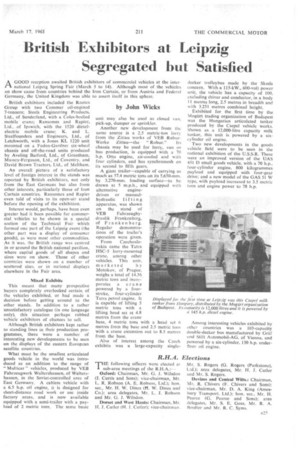British Exhibitors at Leipzig Segregated but Satisfied
Page 59

If you've noticed an error in this article please click here to report it so we can fix it.
by John Wicks
A GOOD reception awaited British exhibitors of commercial vehicles at the international Leipzig. Spring Fair (March 5 to 14). Although most of the vehicles on show came from countries behind the Iron Curtain, or from Austria and Federal Germany, the United Kingdom was able to assert itself in this sphere.
British exhibitors included the Rootes Group with two Commer oil-engined 7-tonners; Steels Engineering Products, Ltd., of Sunderland, with a Coles-bodied mobile crane; Ransomes and Rapier, Ltd., of Ipswich, with the. 1520 dieselelectric mobile crane; K. and L. Steelfounders and Engineers, Ltd., of Letchworth, with a Jones KL 1220 unit mounted on a Foden-Gardner six-wheel chassis and off-the-road units produced by Aveling Barford, Ltd., of Grantham, Massey-Ferguson, Ltd., of Coventry, and David Brown Tractors, Ltd., of Meltham.
An overall picture of a satisfactory level of foreign interest in the stands was reported by British exhibitors, not only from the East Germans but also from other interests, particularly those of Iron Curtain countries. Ransomes and Rapier even told of visits to its open-air stand before the opening of the exhibition.
Interest would, perhaps, have been even greater had it been possible for commercial vehicles to be shown in a special section of the Technical Fair which formed one part of the Leipzig event (the other part was a display of consumer goods), as were most other commodities. As it was, the British range was centred in or around the British national pavilion, where capital goods of all shapes and sizes were on show. Those of other countries were shown on a number of scattered sites. or in national displays elsewhere in the Fair area.
Mixed Exhibits This meant that many prospective buyers completely overlooked certain of the vehicles exhibited, or had made a decision before getting around to the other stands. In addition to a rather unsatisfactory catalogue (in one language only), this situation perhaps robbed vehicle exhibitors of chances to sell.
Although British exhibitors kept rather to standing lines in their production programmes, there were a number of interesting new developments to be seen on the displays of the eastern European satellite countries.
What must be the smallest articulated goods vehicle in the world was introduced as an addition to the range of " Multicar " vehicles, produced by VEB Fahrzeugwerk Waltershausen, of Waltershausen, in the Soviet-controlled area of East Germany. A cabless vehicle with a 6.5 h.p. oil engine, it is designed for short-distance road work or use inside factory areas, and is now available equipped with a semi-trailer with a payload of 2 metric tons. The same basic unit may also be used as closed van, pick-up, dumper or sprinkler.
Another new development from the same source is a 2.5 metric-ton lorry from the Zittau works of VEB Robot
Werke Zittau—the " Robur." Its chassis may be used for lorry, van or bus production, is equipped with a 70 h.p. Otto engine, air-cooled and with four cylinders, and has synchromesh on its second to fifth gears.
A giant trailer—capable of carrying as much as 57.4 metric tons on its 5,650-mm. by 3,270-mm. loading surface—to be drawn at 5 m.p.h., and equipped with
alternative enginedriven or manual
hydraulic lifting apparatus, was shown on the stand of VEB Fahrzeughydraulik Frankenberg. of Frankenberg. Regular demonstrations of the trailer's operation were given.
From Czechoslovakia came the Tatra HSC-5 lorry-mounted crane, among other vehicles. This unit, marketed by Motokov, of Prague, weighs a total of 14.36 metric tons and incorporates a crane powered by a fourstroke, four-cylinder Tatra petrol engine. It is capable of lifting 5 metric tons with a lifting head set at 4.8 metres from the crane base, 4 metric tons with a head set 6 metres from the base and 2.5 metric tons with a crane extension out to 8.5 metres from the base.
Also of interest among the Czech exhibits was a large-capacity single decker trolleybus made by the Skoda concern. With a 115-kW., 600-volt power unit, the vehicle has a capacity of 100, excluding driver and conductor, in a body 11 metres long, 2.5 metres in breadth and with 3.251 metres combined height.
Exhibited for the first time by the Mogfirt trading organization of Budapest was the Hungarian articulated tanker produced by the Csepel vehicle works. Shown as a 12,000-litre capacity milk tanker, this unit is powered by a sixcylinder oil engine.
Two new developments in the goods vehicle field were to be seen in the national exhibition of theU.S.S.R. These were an improved version of the UAS 451 D small goods vehicle, with a 70 h.p., four-cylinder engine, 800 kilogrammes payload and equipped with four-gear drive; and a new model of the GAS 51 W type, with payload increased to 3.5 metric tons and engine power to 78 h.p.
Among interesting vehicles exhibited by other countries was a 103-capacity double-decker bus manufactured by Graf und Stilt Automobil-AG, of Vienna, and powered by a six-cylinder, 150 h.p. underfloor oil engine.




































































































































